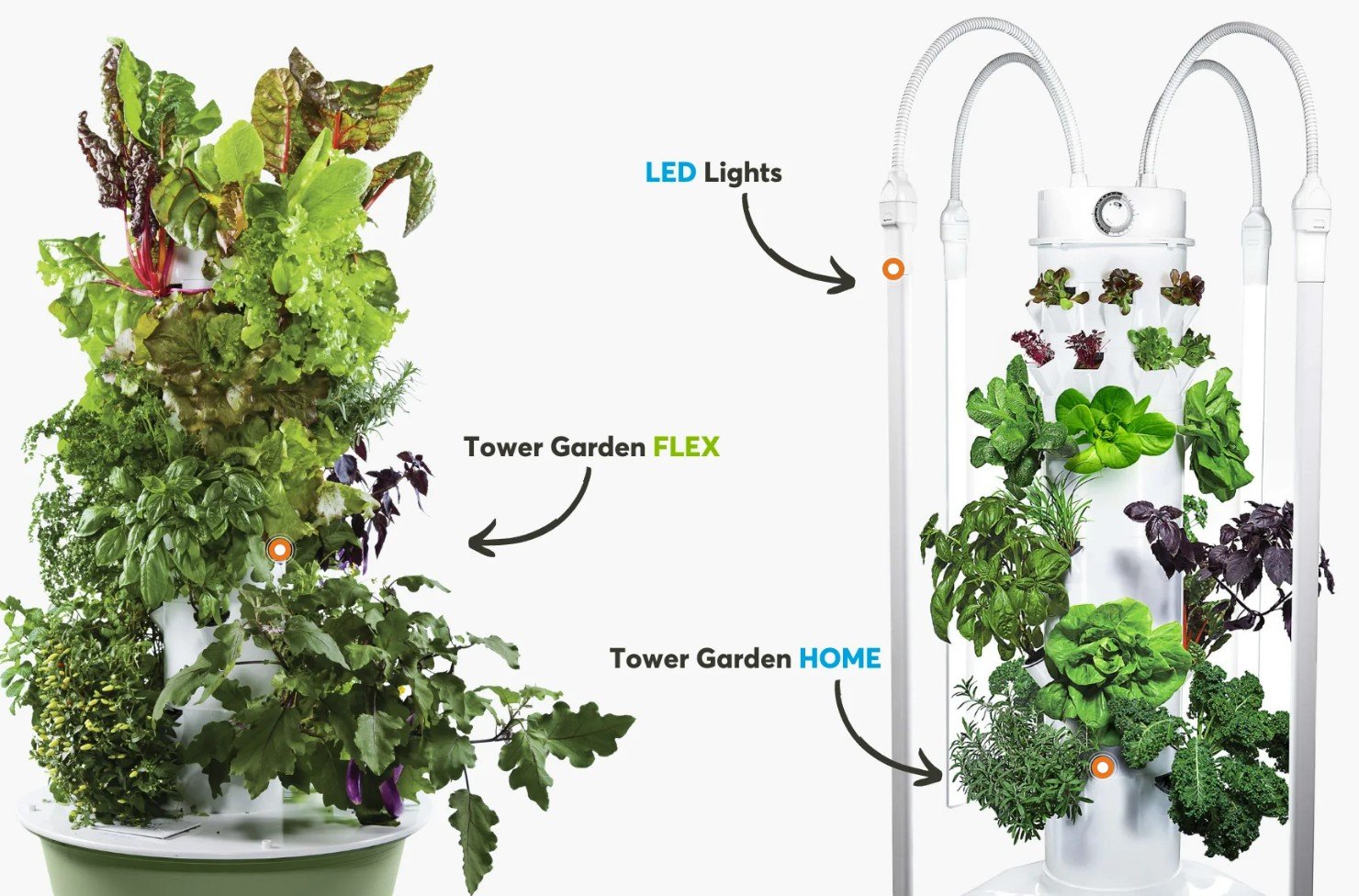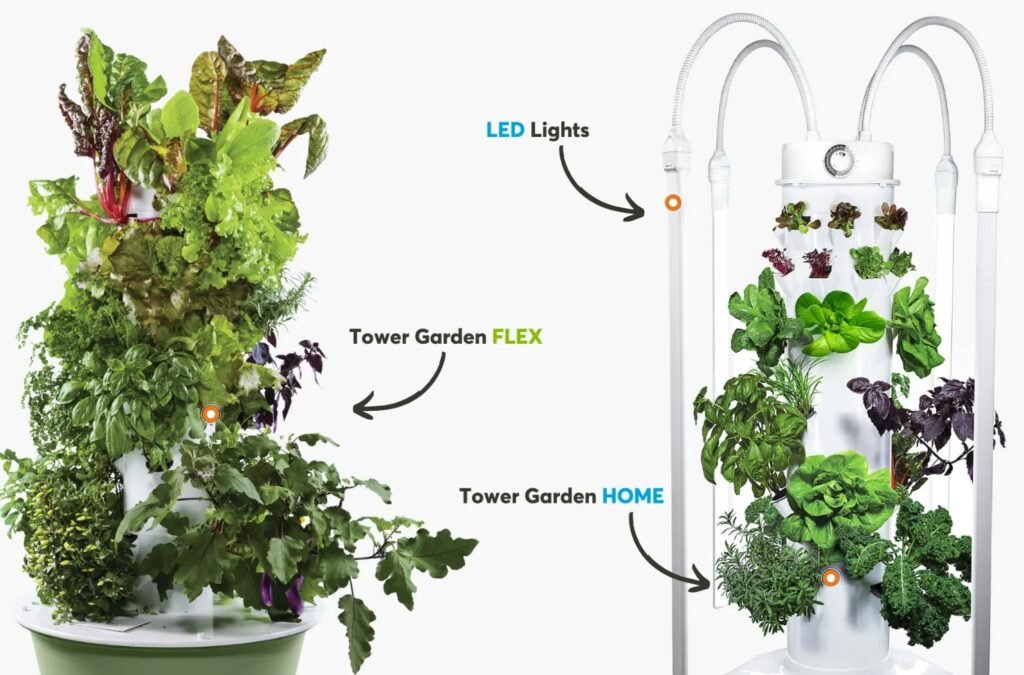If you want fresh greens without grocery run fatigue, Tower Garden has likely caught your eye. It promises pesticide-free produce, compact footprints, and a sleek design that fits patios and kitchens. But is it worth the price?
In this review, you will get a clear look at costs, setup, what you can grow, how much food to expect, and whether you can save money or even earn from it. You will also find pros and cons, care tips, and myths to skip.
What Tower Garden Is and How It Works
Tower Garden is a vertical, aeroponic system that grows plants in a soil-free environment. Roots sit in a tower column while a pump circulates nutrient-rich water to each plant site. The design uses less water than traditional gardening and produces fast-growing leafy greens, herbs, and some fruiting plants. It is popular with eco-conscious families, apartment dwellers, and small food-preneurs who want local produce year-round.
Why Tower Garden Is Expensive
The upfront sticker shock is real. The price includes food-grade, UV-stabilized plastic, a submersible pump, timer, reservoir, net pots, starter plugs, and proprietary mineral nutrients. You also pay for engineering that delivers even water distribution and stable roots, plus customer support and replacement parts. Compared to DIY hydroponics, Tower Garden costs more because it is turnkey and tested, with fewer fiddly parts for you to source or troubleshoot.
Ongoing costs include electricity for the pump and optional grow lights, nutrients, seeds or seedlings, and occasional replacement of pumps or timers after years of use. If you live in a colder climate and want year-round growing, lights add the biggest cost, but they also unlock reliable winter harvests.
What You Can Grow, and What You Cannot
You will see the best results with:
- Leafy greens: lettuce, spinach, kale, arugula, Swiss chard, pak choi
- Herbs: basil, mint, thyme, oregano, dill, parsley, cilantro
- Fruiting plants with compact habits: cherry tomatoes, cucumbers, peppers, strawberries
- Edible flowers: nasturtiums, calendula, violas
Plants that struggle or do not fit well:
- Root vegetables: carrots, beets, potatoes, onions, and radishes need depth and loose soil
- Large or heavy vining crops: pumpkins, winter squash, full-size melons require heavy trellising and can overwhelm the tower
- Woody perennials and trees: blueberries, citrus, and dwarf fruit trees are not a match for the tower’s pockets and reservoir
Mushrooms are also out, since they need a different substrate and environment. If in doubt, ask: does this plant have small root systems and modest weight? If yes, it is likely a fit.
Yield Expectations: How Much Food Can You Grow?
A single tower can hold dozens of plant sites, so weekly harvests add up. Here is a reasonable expectation for a well-run tower with mixed crops:
- Lettuce: 20 to 30 heads per month once the rotation is established
- Herbs: several cups of cuttings per week
- Cherry tomatoes: 1 to 2 pounds per week at peak, depending on variety and light
- Strawberries: small but steady bowls once established
Climate and lighting matter. Outdoor sun in warm months grows faster than indoor setups with minimal lighting. The key is staggered planting. Start a few plugs every week so your harvest never hits a lull.
Setup and Care: What It Really Takes
Setup time is about an hour or two for most people. You assemble the column, fill the reservoir, add nutrients, and insert seedlings or seed-started plugs. If growing indoors, assemble lights and set a timer. After that, ongoing care looks like:
- Check water level twice a week, top up with water as needed
- Refresh nutrients every 10 to 14 days and monitor pH around 5.5 to 6.5
- Prune and harvest regularly to prevent crowding
- Rinse the pump filter monthly
- Deep clean the system every 6 to 8 weeks between crop cycles
The routine is simple once you get the hang of nutrient mixing and pH. A small handheld pH pen and mild cleaning solution go a long way.
Advantages You Will Notice
- Fast growth and high density in small spaces
- Clean produce without soil pests or weeds
- Water efficiency compared to raised beds
- Predictable results, especially with lights
- Modular design that scales for homes, schools, and micro-farms
Disadvantages to Consider
- High upfront cost compared to containers or a small raised bed
- Reliance on power for the pump and lights
- Learning curve with nutrients and pH
- Not ideal for root vegetables or bulky crops
- Noise from the pump in quiet rooms, usually minimal but noticeable at night
Is a Hydroponic System Worth It?
If you value clean greens on demand, less food waste, and the ability to grow off-season, hydroponics is a strong yes. You trade soil chores for light maintenance, and you control inputs. If you only want occasional herbs, a windowsill planter may suffice. If you want a steady salad bar, hydro wins. For families, nutrition-minded cooks, teachers, and local food vendors, consistency and speed make it worth it.
Savings and Earnings: Realistic Numbers
Savings depend on what you grow and grocery prices in your area. A modest indoor setup often yields 10 to 20 pounds of produce per month, mostly greens and herbs. If you value organic greens at 8 to 12 dollars per pound, that is 80 to 240 dollars of monthly equivalent value at peak. Subtract nutrients, water, and electricity, which often land between 15 and 40 dollars per month for a home tower with lights. Your net savings can be meaningful over time, especially if you grow year-round.
Can you earn with a tower?
Yes, but be practical. Here are common paths:
- Sell herb bundles or salad mixes to neighbors, CSA add-ons, or local cafes, if regulations in your area permit
- Offer seedling starts in spring using your tower as a propagation station
- Host workshops or tours for schools and wellness groups
A single tower can cover its costs in 12 to 24 months if you maximize production, limit downtime, and choose high-value crops like basil, specialty lettuces, and micro cucumbers. Multiple towers make a better case for side income since you can supply consistent volumes. Treat it like a tiny farm with planting schedules, harvest logs, and simple budgeting.
Common Misconceptions to Skip
- It is set and forget: you still manage water, nutrients, and pruning
- All plants thrive: roots and heavy crops are not a match
- It is only for experts: beginners succeed with a short learning period
- It is not sustainable: water reuse and reduced transport miles are real environmental wins
Two Short Case Snapshots
- Family of four in a condo: One indoor tower with lights produced weekly salads, herbs for cooking, and a few cherry tomatoes. They reported fewer grocery trips and kids eating more greens because they picked leaves themselves.
- Weekend market vendor: Three outdoor towers in warm months, one indoor with lights in winter. They focused on basil, lettuce, and mint. With steady harvests and recurring buyers, they covered monthly costs and built a small profit, mainly by keeping crops consistent and fresh.
Final Take
Tower Garden is not the cheapest way to grow food, but it is one of the most space-smart and reliable. If you want fresh, clean produce, you will appreciate the speed, water efficiency, and convenience. If you want to test a green side hustle, start with greens and herbs, build a planting rhythm, and scale if demand appears. Ready to learn more about why an aeroponic system fits modern homes? Explore our guide to tower garden and when you are ready to buy tower garden, compare features and costs to make a confident choice.






